This article was written and published in 2001.
Every year there is new equipment in the Hockey industry, and some references to heat molding and other types of equipment may become out of date. The information on Hollows, Mounts, and the fit of boots, has not changed and is unlikely to.
HOCKEY FROM THE ANKLES DOWN
BY TODD ALEXANDER
Master Skate Technician
October 2001
A cold front came in over night at a small rink in the south east. We were the visiting team and I had just had my skates sharpened by someone I did not know. We were the first game and I was the first to hit the ice, and within only a few strides I knew something was different, the speed was incredible… I just kept on going!
As a young Bantam this was the first time “skating” felt so effortless, and I had been skating since the age of 6. That feeling and that game has stayed with me, and though I didn’t know why then, I did know it all had to do with the sharpening that day. Today, I know so much more and can probably take a good guess that the hollow in my skates was very shallow and because the rink was so cold, the ice had become very hard.
I look back and wonder why no one had taught me then that hollows have actual measurements other than deep or medium, and those hollows should be adjusted according to the ice you are skating on. As a young skater, all I knew was that I liked my edges sharp. After that day though, I would have loved to have known how to maintain that freedom, and speed, and that slightly out of control feeling that gave me such a thrill…I would have had my skates done that same way from then on.
You would think that today’s players would be smarter than I was over 40 years ago, but then again, how do today’s players learn about their equipment? The majority of the players learn from each other in the locker room or from trial and error. Even worse, some never do learn that some of the difficulties they have on the ice require only simple fixes.
I have spent time with “professional” hockey players, educating them on hollows, mounts, and proper fitting techniques for boots, yet this is information they should have had when they were Peewee age players. Today’s coaches teach skills, systems, off-ice training, and even nutrition, but I have yet to hear a coach talk to his team about their skates.
Somehow, I find that almost negligent, since there are few things that have more impact on the accomplishment of the fine skill of skating than their skates and how they are maintained. Consider the possible futures of our young hockey players if they at least had a basic knowledge of their game from the ankles down…
Mounts
During the summer some semi-pro players will join summer adult leagues just to keep their skates under them. I’ve met professional players who had no idea that the blade could be moved on the boot to adjust for a particular skating problem. The question I always ask privately is, “I wonder how far that player might have gone if someone had noticed their foot problem a little sooner in their career?”
After a young figure skater learns to do his or her first half revolution jump, their next purchase of new skates will require them to buy the boots separate from the blades. This allows them a choice in type of blade and the ability to mount the blades in a precise location for that individual skater.
On the hockey side, players take what they get out of the box, ask to have an edge put on them, and then rarely if ever look at the bottom of their skates except to see if they need a new edge. Many hockey players look to figure skaters for tips on skating technique. Maybe they should also learn from their boot fittings and blade maintenance techniques.
Here are a couple of basic guidelines for where a blade should be located on the boot. First rule is to mount the blade back as far as possible. If the sole of the boot is longer (heel to toe) than the blade chassis, leave the majority of the extra space at the toe of the boot. A little over two decades ago we started teaching our skaters to settle back in their stride, telling the skaters to start their stride pushing with the heel of their blades, not the toe.
We have found that keeping the weight off the balls of the feet is a more efficient skating stride. (This stride being separate from the speed start, which requires the skater to get and stay on the toes of the blade for the fist few steps.) Figure skaters are commonly asked to teach efficient hockey strides, but in reality, it is the design of the figure blade that dictates the proper technique.
In order for a figure skater to keep from tripping over the toe pick, he or she is forced to settle back on the blade, and forced to use a push directed more to the sides rather then pushing straight back. For the hockey player, using this technique produces a longer push for every stride resulting in more distance for each push, thus greater speed; much like speed skaters who take this sideways push even further.
Now we look at the other end of the figure skate and see that the blade extends well past the heel, giving the skater more blade to settle back on.
Yet, it is not uncommon to pull a new pair of hockey skates out of a box and find the blade is mounted a quarter inch or more forward from the heel of the boot. Consider how much of the skater’s weight is actually hanging off the back side of the blade. Add the tail rocker on the heel of the blade (the extreme curved area that the player can’t actually skate on) to that quarter inch, and now the skater has MORE then an inch of his or her heel hanging off the back side of their blades.
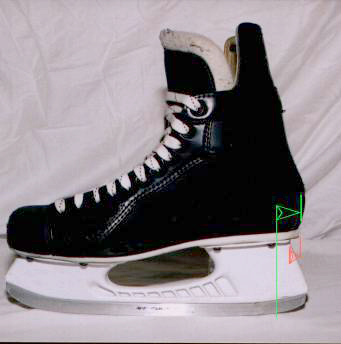
Moving a blade back on a boot will actually make it easier for the skater to get to the toes of the blade for their speed starts. Mounting a blade as close to “heel to toe” as possible will help the skater achieve their most efficient stride, as long as the boot is not too big on the foot.
The second adjustment for a mount is side to side. A “center mount” refers to a center location from side to side on the bottom of the boot, roughly a line from the center of the toe cap to the center of the heel. The mistake most people make is they should be locating the steel blade on the boot, instead of the plastic chassis, or blade holder.
Some chassis lean inward slightly, and centering the mounting plate of the chassis in the middle of the boot actually locates the blades too far to the inside of the boot. Using the manufacturer’s seam on the chassis will help line up the actual blade, by aligning the seam to the middle of the toe cap and the center of the heel. Be aware that some of the graphics and stitched seams on the boots will make finding the center of the heel more difficult than it sounds.
Now we get into an area that requires an expert be involved. Many players have pronation, or fallen arches, which will effect the location of the blade for that individual player. The mistake that nearly every buyer makes is, they assume the manufacturer has properly mounted the blade on the boot; thus, any problem the skater is having on the ice, is the problem of the skater and they just have to try a little harder or be a little tougher. If there is a problem with the ankle of an accomplished skater rolling in or out, the equipment can be adjusted to help the skater compensate.
A pronation is the act of a foot rolling inward, when weight is applied. Let us use the example of fallen arches or “flat feet”, which is usually hereditary and is solved in street shoes by adding extra arch support or using an orthotic.
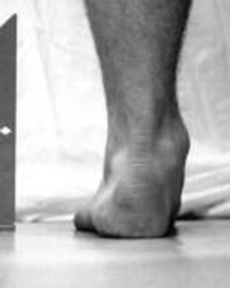
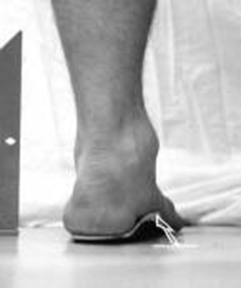 Note: there is a difference between reshaping the foot in the boot, and solving a pronation. Adding arch support or using “cookies” to build up the arches, is an example of reshaping the foot within the boot. The use of an orthotic, usually a solid insole that has some kind of twist from midfoot to heel or one side of the insole is thicker than the other, is also reshaping the foot but with the expressed intent of trying to straighten an ankle that leans in too much.
Note: there is a difference between reshaping the foot in the boot, and solving a pronation. Adding arch support or using “cookies” to build up the arches, is an example of reshaping the foot within the boot. The use of an orthotic, usually a solid insole that has some kind of twist from midfoot to heel or one side of the insole is thicker than the other, is also reshaping the foot but with the expressed intent of trying to straighten an ankle that leans in too much.
In street shoes, this twist or leaning heel acts as a wedge or shim between the ground and the foot, thus straightening the line from the heel up through the ankle. (The Achilles tendon is the best focal point for spotting this alignment.) In other words, the wedge adds an additional upward pressure to the inside of the foot keeping the foot from collapsing or rolling inward to it’s natural position.
That same wedge does not work when inserted into a skating boot. Because you are balancing on an eighth of an inch piece of steel two or three inches off the ice, there is no ground to support the shim. There is no source for the additional upward pressure because there is only air under the orthotic, so the foot goes back to its original lean.
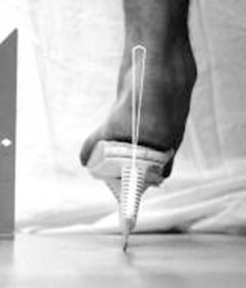
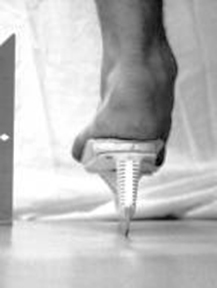 Repositioning the blade on the sole
Repositioning the blade on the sole
only 1/4 of an inch to the inside,
can have huge effect on the balance
and performance of a skater.
The only way to stop a pronation of a skater is to move the blade to the inside, thus moving some of the weight on the foot to the out side. Maybe the best way to envision this is by thinking about a tightrope walker. There are some trainers and skate technicians who leave the foot in leaning position and straighten the blade by adding a shim between the blade holder and the boot along the outside edge of the boot.
My experience has been that a skater will have more power and a longer skating career if the foot can be aligned into the proper posture. Once that balance point under the heel is found, you will see a straight line from the bottom of the heel up through the ankle to the knee. I am not discounting the use of orthotics and arch supports, in fact there is much that can be accomplished with corrective insoles, but they will not stop the lean to the inside.
Many times it makes it worse, and the blade has to be adjusted for both the foot AND for the orthotic insert. What is amazing to me is how most boot manufacturers have a real problem understanding this basic law of gravity. The boot makers believe the stiffness of the boot will hold the ankle straight, and it does for a while, up to the point where the boot starts breaking in and then the creases in the boot allow the ankle to role in again.
These pressure points during break in are usually extremely painful, and can lead to medical problems ranging from bone spurs or stress fractures to muscle or ligament damage in ankles and knees. These same pressure points are also signs of what adjustments might be possible.
Since we want our boots to mold to our feet, and flex when we bend our knee, (as opposed to the plastic molded boots used for rental purposes), coaches need to recognize when a blade needs to be adjusted for the skater’s needs. Figure skating blades have special holes in the blades to allow them to be temporarily mounted and moved back and forth, while the skater breaks in the boot.
When the skater and the instructor are happy, the blade is then permanently attached to the figure skating boot. At present, this is not an option for hockey players, so finding someone with experience in adjusting mounts for skaters is the best direction a coach can take when faced with this kind of problem.
One other huge oversight when considering blade location is the fit of the boot. If a boot is too big for the skater, imagine where the blade is located on the foot. A boot should only allow 1 to 1-1/2 sizes of growth room, allowing the young skater a chance to grow into their boot before the boot breaks down (those deep creases that show lost ankle support and loss of boot life).
Parents need to understand that two or more sizes in a boot does NOT mean they won’t have to buy new skates next year. In fact, an improper fit speeds up the break down process and puts the narrow arch of the boot forward enough to put pressure on the widest part, the ball of the foot. To fit a boot, slide a skater’s foot to the front of the boot and look at the space left behind the heel will tell the coach how much room there is in the boot. The width of a pencil, or ¼ inch, is approximately one full size. The width of a Sharpie Marker or a man’s pointer finger is usually 1-1/2 size of extra room, allowing growth without giving up skating performance. Add a second insole under the existing insole to fill that room in the boot left for growth.
Do not use multiple socks, as this will promote movement in the boot and loss of performance, much like rental skates.
Also, both skaters and coaches need to know that it is not the top eyelets that need to be the tightest. It is the eyelets at the bend in the boot that hold the heel in the pocket that are the most important, usually a group of three holes located about two or three holes down from the top of the boot. Only when the heel is firmly set into the heel of the boot does the skater gain the full potential of the boot’s support and blade location.
Rockers
Not too many years ago, well rockered skates were considered a sign of a good skater. Actually, back then, what players were looking for was pinpoint turning ability to help maneuver in front and around the back of the net, a maneuver Gretzky made popular. In recent years, different skating techniques have been stressed to all skaters, and the bigger skaters are now moving with the same speed as the smaller skaters.
Thus speed is now more desirable then the ability to dance around the net. Instead, players are expected to stand their ground in front and behind the net, and forwards are looking for speed through the “slot” in front of the net. Flatter rockers are preferred today, at least on the back two thirds of the blade where the basic stride comes from.
For an extreme example of how flatter rockers produce more speed, look at speed skates. Long track speed skates are totally flat, distributing their weight over a larger space, thus keeping them on top of the ice, which means less drag or greater ease to maintain speed.
Only a slight increasing of the rocker at the heel is recommended for turning, but only 1or 1-1/2 inches (no more than 2) from the back of the blade. There are a couple of tricks that can be used at the toe of the blade to adjust a rocker to an individual player’s preference. For players that do a lot of speed starts one can flatten the front 2 or 3 inches of the blade, removing any high points that would keep the skater from rolling forward to the ball of the foot easily.
Inversely, leaving the steel on the blade at the toe and trying to maintain the same blade rocker as far forward as possible, will allow defenseman to skate more on the ball of their feet and get a better push on their backward stride. It is important for coaches to understand that when they are teaching skaters to settle back in their stride they are skating forward, but when going backwards they will spend more time on the balls of their feet.
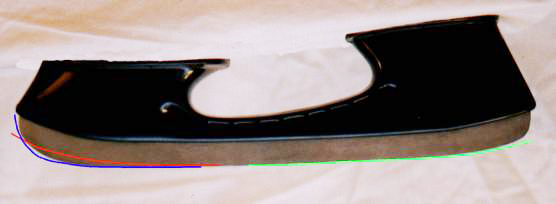 I am not saying that a winger or center can not skate backwards, but that we can adjust the rocker of the blade to accentuate a certain aspect of a player’s game. Once again the mistake that most people make is assuming the new blade on a skate coming out of the box, is the rocker that that skater needs. More times then not, the rocker on one blade will not match the rocker on the other blade of the same pair of new skates, no matter how much you paid for them.
I am not saying that a winger or center can not skate backwards, but that we can adjust the rocker of the blade to accentuate a certain aspect of a player’s game. Once again the mistake that most people make is assuming the new blade on a skate coming out of the box, is the rocker that that skater needs. More times then not, the rocker on one blade will not match the rocker on the other blade of the same pair of new skates, no matter how much you paid for them.
Spending time with a qualified skate technician is the best way to decide what rocker will help their game. In some cases, a little trial and error is necessary, so making small adjustments over a short period of time is the best way to make changes to a player’s rocker.
Hollows
Over the years I have heard a lot of funny statements; “Just sharpen my skates a little bit”, “I want a defenseman’s cut”, “because I’m a bigger player, I need a deeper hollow”, “just sharpen them the regular way”, “I only get my skates done once a year”, “can you put an edge on my Rollerblades?”. What is amazing is how little is known about the subject of hollows, even at the higher levels of hockey. That means there is very little instruction being given at any level for what might be one of the most important aspects of a skater’s skills.
“How sharp are your skates?” This is a good question requiring an answer more then yes or no. Different hollows control the sharpness of your skates, although all should have a good edge, some hollows have more bite in the ice. The first thing to understand is that the deeper the hollow the more the edges sink into the ice and the less glide the skater will have between each stroke.
The extreme example is the long track speed skater whose blades have no hollow. They have a good edge, but the bottom of their blade is totally flat which causes no drag. So we now have high-level hockey players on very flat hollows in order to maintain speed which takes less effort.
For the accomplished hockey player, they must find that balance between speed and grip. The grip comes into play in the corners and in front of the net. Players push on each other and the one who can’t hold his edge is the one that moves. Thus we must analyze the player’s game style, position, and comfort level. For game style, consider their size and whether they are looking for speed or for power.
A player’s position usually has an affect on their game style, and for comfort one should find the least amount of hollow that allows them to maintain their game style and position. In other words, there is a difference between the forward flying through the slot and the defenseman who is expected to stop him.
Let’s say the defenseman is a big guy who is not a particularly fast skater but is expected to keep the slot clear. Less hollow is not going to make him a better skater, but a deeper hollow will give this player more grip in front of the net. On the other hand, if a coach expects a fast defenseman to join in the attack, I would recommend less hollow to help with speed, both in the attack and getting back when caught in too deep. Most forwards are looking for speed, so less hollow is the answer.
A player with less weight might be better off with a little deeper hollow. Less weight will not sink the edges as deep in the ice, but sharper edges may help with the physical game in the corners. Another benefit players have found from less hollow is fewer injuries. Because the edges are not so deep into the ice, their blades don’t get stuck in the ruts as easily, thus there are fewer groin and knee injuries.
There are still players who don’t like to get their skates sharpened very often. In my opinion that is because they have not had a professional take care of their skates yet, and they don’t know what they are missing. The past statements still hold true in that they want their “dull” skates not to catch in the ruts, and also have the easy flow for speed, but for these skaters I would recommend a deeper hollow that is purposely dulled back to their comfort level. This is still an efficient edge, but I find it easier to keep a player’s skates sharp rather then finding a consistent dull edge that always feels the same, game after game.
Goalies
Goalie skates have changed over recent years. Actually, the way we sharpen goalie skates has changed as the techniques and styles that goalies use have changed. It used to be all goalies wanted their blades flat on the ice from toe to heel, and only enough edge so they could stand in the net.
Today, goalies are expected to skate and stickhandle, which requires a little rocker on the blade to help with cornering and pivoting. Since they spend so much time down on the ice, today’s goalies need sharp edges to help them recover to their feet quicker. Weight and strength are the biggest issues with goalie hollows.
On one hand, they need sharp edges to get up, yet on the other, they need dull edges to shuffle. Younger skaters with less strength will have difficulty trying to shuffle on skates that are very sharp. As the goalie gets stronger, the hollow can be deepened, all the time finding that balance so that a goalie can both set an edge for the push and release an edge for the shuffle as they move across the net.
The inside edge is the edge most used. I have even purposefully left the inside edge higher than the outside edge for a couple of goalies, both for stronger grip and to lessen the chance of catching an outside edge on the shuffle. Because every goalie has a slightly different style, they also have different needs when deciding on a hollow in their blades and how sharp to leave the edges.
We seem to have come to an age where the hollows are reversed from what they were several years back. The goalie’s hollows are now deeper than the forward’s hollows. Today’s goalies are even adding pieces of steel called “Overdrive Blades” to the inside toe of their boot, allowing them to push into the ice with the inside of their boot while they are down in their butterfly.
As far as the fit of a goalie skates, you can leave up to two sizes of growth room. Some skaters keep their skates a little big even after their feet stop growing to leave some room in the toe box for stopping those hard slap shots.
Very little can be done for a pronation in goalie skates. Sometimes there is a little room to move the boot inside the cowling but it is usually minimal. Overall I still find goalies pay very little attention to their edges. I still see goalies who get their skates sharpened only once or twice a year, and others who have so much rust on their blades that when the rust is finally removed the blade becomes loose in the holder. Just like the forward and the defenseman, their edges are in constant use and all these skaters should give their edges at least as much attention as they give to their sticks.
Conclusion
Skiers decide what type of wax they put on their skis when they reach the slopes, race car drivers use specific tires for different road conditions and temperatures, yet it is amazing how few hockey players are aware of what hollow they presently have in their skates, much less adjusting that hollow according to what the ice temperature is. Those that are aware take very special precautions to insure the quality of their sharpening, for example: learning to do the work themselves, or mailing extra pairs of steel to the professionals they trust.
At the higher levels’ in any sport, the gap between good and excellent becomes very small; so as athletes become more educated, they will make sure they get every advantage possible out of the equipment they use.
I foresee the importance of skate sharpening becoming a major focus on teams with hired staff. In lieu of an equipment manager, who sharpens skates, we will see a skate technician as skilled on the sharpening machine as the players are skilled at playing hockey.
As coaches realize the benefits of having players with properly fitted and maintained skates, they will start searching out those professionals who can give their team that slight edge over the other teams. The coaches at the lower levels of hockey, without the extra staff, may not need to be experts in all the issues of producing a good hockey player, but they do need to be familiar enough to recognize experts in the specialized areas of nutrition, off ice training, and of course skate maintenance.
Placing some focus on these specialized fields will enhance the quality of the teams they are building.
ACKNOWLEDGEMENTS
Cliff Cook
For the photography and his help with the computer.
Joe Delio
For his specialized training in the field of “Skate Technician”.
My wife, Bobbie, and my family
For editing and checking the spelling. And of course the positive support in the pursuit of this quest.
